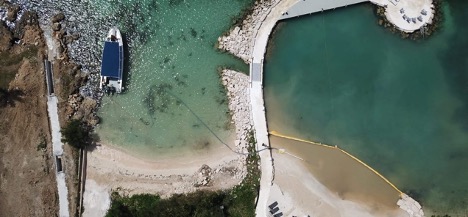Controlling turbidity is an essential part of having a safe and compliant construction, dredging, or maintenance operation.
During dredging, piling, shoreline, dock, and bridge construction jobs, turbidity control is essential to keeping your site in compliance. Permitting requires contractors to ensure control of the silt and turbidity produced by construction near, on, or over water. Black staked silt fences are commonly seen around roadside construction, but in-water floating ‘silt fences’, known as turbidity or silt curtain, are required to properly control turbidity in water-based applications.
How does a turbidity curtain work?
A turbidity curtain acts as a protective barrier that contains turbidity and sediment to your site location. Properly selected and anchored barriers help to control the turbidity at the source and prevent contamination of waterways.
The floating turbidity barrier typically consists of a long curtain or ‘skirt’ that should extend to at least one foot from the floor of the water body. The bottom of the turbidity barrier has a ballast chain that helps to sink the reinforced material and help maintain the device in an upright position. The top of the silt curtain contains a series of flotation devices welded into individual pockets to create buoyancy and maintain performance. This balance of floating and sinking helps to provide a vertical face for fine suspended particles to settle to the bottom with time and gravity. This in-water ‘fence’ or ‘curtain’ is not designed to stop water flow with 100% containment, but to provide time and a barrier to allow nature to take its course (see Stokes Law). Alternatively, some job sites with restrictive permitting requirements for NTU over background may require primary, secondary, and even tertiary systems to ensure sensitive areas receive full coverage and protection, or chemistry for flocculating fines into larger particles for proper settling in the conditions.
What factors determine which turbidity curtain to select?
When looking for the right silt barrier to use in your construction location, there are some main factors to take into consideration. Major factors include: wind, waves, current, body of water, water depth, duration of the project, and water contamination levels.
Water velocity: One of the major distinguishing factors in turbidity control is the waterway you will be working in and the speed of the current both at the surface and below. When demanding forces such as waves and wind also come into play, the strength of the barrier’s load-bearing components need to be increased to handle those increased conditions.
Site Conditions and Applications: As important as the consideration of the current, waves, wind, and upstream erosion control in your area, specific permitting requirements for turbidity sampling, general site functions, along with your project engineer’s recommendations should be considered.
Soil Type: If the soil you will be producing is contaminated, there is a need for increased turbidity control to prevent contaminated water from entering other systems. In these cases, at least primary and secondary barrier designs should be utilized. If the soil type is extremely fine, as in the case of clay, additional chemistry may be required with the use of flocculant or polymers within a defined treatment area.
Project Duration: The length of your project is often a consideration for turbidity control. The longer your project lasts, the greater the potential for large volumes of sediment. Materials should be selected that will be robust enough to last the duration in the weather conditions in the area. Turbidity barriers need load-bearing components able to handle the water conditions in your location over time, as well as the amount of sediment your area is producing.
Important to note: All floating barrier systems should be removed prior to sheet icing conditions or major storm events.
What are the different types of turbidity curtains?

The following is a brief overview of the main three types of turbidity curtains:
Type 1: The Type 1 Barrier is designed for the least demanding applications and/or short-term projects. It has often been implemented in calm water applications and should not be used in water areas that have waves or moderate to high flow rates. This curtain is appropriate for areas where load-bearing factors are not high, as each section of the curtain attaches to the next with grommets and zip ties. Each section comes with one anchor point on each end.
Type 2: The Type 2 Turbidity Curtain is more common for water applications with milder moving water conditions (i.e. rivers, lagoons, lakes, and streams). It has been used during pile driving, demolition work, and silt control in waterways, rivers, and canals. A general recommendation is that this barrier should not be used in water with a velocity higher than 1 knot or waves higher than 2 feet. The Type 2 silt barriers have metal end connectors and corner plates to provide shock absorption for the cables that run the length inside each section.
Type 3: The Type 3 Turbidity Barrier is high in strength for water applications with conditions that will cause more force on the system (up to 1.5 knots). It is commonly used in dredging, demolition, and dam repair where current, wind, waves, and depth factors require the most robust metal components, end connectors, and cables to ensure the force of constant motion are properly absorbed and dispersed. This curtain can be selected with impermeable material for the skirt that hangs below the water, or permeable materials that allow for some waterflow. Permeable curtain is often used in areas with higher currents and even in conjunction with impermeable barriers which may provide secondary containment.
Controlling turbidity is an essential part to having safe, compliant, and environmentally responsible construction, dredging, or maintenance operations involving sediment near a water body. Speak to one of our representatives at GEI Works for more information, assistance in selection, or in-stock options.
Contact Our Team at GEI Works to discuss your project and develop a solution.
geiworks.com | (772) 646–0597 | info@geiworks.com



